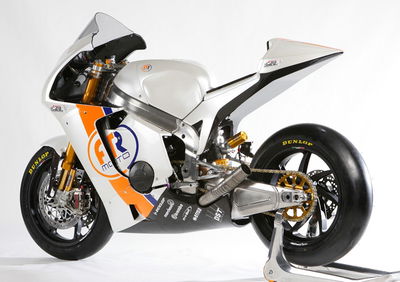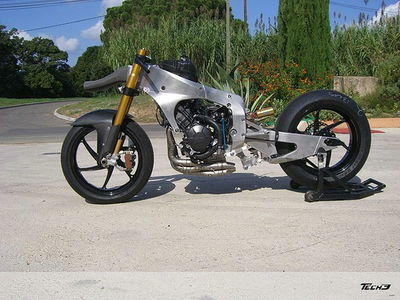Steve Bones (FTR) - Q&A: Moto2.

Frame and chassis builder FTR Moto has unveiled its M209 motorcycle, which will be available for teams entering next year's inaugural Moto2 World Championship.
The company, which has previously worked with the likes of Team Roberts and KTM, will race the machine in the final two rounds of the Spanish Championship, at Jerez on November 15 and Valencia on November 22, with British rider Graeme Gowland.
Here, FTR Moto director Steve Bones answers questions on the project, including the exact pricing...
Q:
What attracted FTR Moto to the new Moto2 category?
Steve Bones:
We've produced racing motorcycles for the past 15 years for a number of customers and when Moto2 was conceived we knew it was a prefect fit for our business. As Fabrication Techniques we were known within motorcycle racing but Fabrication Techniques has other lines of business aside from motorcycle racing so FTR Moto was launched. FTR Moto is completely focussed on motorcycle racing and Moto2 has therefore become the first project for FTR Moto.
Q:
The Moto2 rules were announced in January but changes have been made since, how have you dealt with that during your design and build process?
Steve Bones:
By being cautious really. It was clear from the start that further discussions would be required before the new Moto2 regulations would be finally approved. The initial rules offered an opportunity for any engine manufacturer to participate, for ECU's to be limited in cost to 650 Euros, there were minimum weights and rpm limits for two, three and four-cylinder motors and different rear wheel rim options. We did our research and knew that some of those regulations would change so it was important to get out initial prototype as close to what we actually wanted for 2010 as possible.
Q:
But in Spain there were a handful of teams willing to participate in the Spanish Championship straight away, how did you feel about that?
Steve Bones:
We initially felt that we may miss the boat in terms of selling our rolling chassis to teams but then the rules began to change. We had a Yamaha engine in the workshop and were considering building a frame and rolling chassis around that but then news came through that the new Moto2 World Championship was changing to a single-engine regulation. It was clear that we would now need to be 100 per cent confident of any direction we took in the design and build of the M209 prototype.
Q:
Moto2 was conceived to replace the 250cc class from 2011 with an allowance to participate in 2010, but it seems all of the 2010 teams will race Moto2 machine. Are you surprised at the popularity of the new class?
Steve Bones:
I suppose you have to be a little surprised but Moto2 was introduced to reduce costs and I think the 250cc costs became too excessive for any teams plus, in 2009, the number of teams and riders has again declined. Perhaps for many teams the Moto2 initiative offered the opportunity of both survival and a return to competitiveness. From a simple accounting position, paying more than half a million Euros for a 250cc factory machine or ?90,000-?100,000 for a Moto2 machine means the new class is certainly financially attractive."
Q:
What were your design objectives for the first prototype M209?
Steve Bones:
We've produced lots of racing machinery, for Team Roberts, KTM GP etc. but our customers have always arrived at our front door with a clear and concise idea of what they want. We knew that we were capable of implementing our own ideas but innovation is always a potential gamble so it was naturally impossible to do that at the cost of our customers. With the Moto2 project we recognised that a culmination of our experience and fresh ideas could lead to something new, innovative and exciting, hence the M209.
Q:
You have a number of recognised partners in the project, how did you decide which partners to introduce to the M209 prototype?
Steve Bones:
From the start we considered every scenario in terms of what a customer may or may not want. Some of the more experienced world championship teams will know exactly what they want so they may require a rolling chassis less our Ohlins suspension or Brembo brakes or they may want Brembo brakes and Ohlins suspension but not our Marchesini wheels. Some teams have long-standing agreements with technical suppliers so that has to be acknowledged. But overall we opted to cater for the team that has no obligation to technical partners and want to be competitive instantly. We believe that our commitment to a range of high quality technical partners and high quality technical products will satisfy those needs."
Q:
What do you see in the M209 that offers new technological innovation to the World Championship arena?
Steve Bones:
Overall, in each area of the machine, we've recognised what has been produced previously then addressed each area and improved on it. We've questioned certain trends and the traditional production methods in each of those areas and then we've improved them and also looked to introduce our own, experimental advancements. We've considered every aspect carefully and introduced our own design and finish completely. The machine has been designed and built 100 per cent from the ground up. From a performance perspective we've adapted the conventional steering method to our own and that will form the first stage of our research and development."
Q:
You have an agreement and partnership with the Joe Darcey Team in Spain, how will that assist the progress of the FTR Moto prototype and the Moto2 project?
Steve Bones:
The Joe Darcey Team has a successful Supersport programme in the Spanish Championship and they've been interested right from the very start of the FTR Moto project. For FTR Moto the Joe Darcey Team relationship is ideal, we have no aspirations to run a race team as we're just a constructor and they have no aspirations to race in Grands Prix so the mentality from both parties is clearly understood. Miguel Gomez and Anton Grushka of the Joe Darcey Team have provided everything we've needed in terms of a development Honda engine, wiring loom and everything that IRTA will supply to the GP teams once the new World Championship is under way next year.
Q:
How will FTR's Moto2 project proceed for the remainder of 2009?
Steve Bones:
We're delivering the initial prototype to the Joe Darcey Team for the fifth round of the Spanish Championship on October 9-11 at Montello, Barcelona. The team will test the machine during the Friday practice and Saturday qualifying, with their former superbike rider Diego Lozano and they will make a decision on whether or not to race the machine based on the Friday and Saturday work. From there the Joe Darcey team will continue to test the M209, at Valencia and possibly Jerez, before racing in the final two rounds, on November 15 and 22, with British rider Graeme Gowland.
Q:
As a constructor you are aiming to attract sales to teams contesting the 2010 World Championship and Spanish Championship, how is that going?
Steve Bones:
Considering nobody has actually seen the M209 yet the interest and enquiries have been very encouraging. We've made a simple price plan for the product we're offering so it's not over complicated. We're confident the FTR Moto project will prove popular and our approach is very much long term. The Joe Darcey Team operation in Spain will also act as a distributor so the guys there are also dealing with lots of enquiries.
Q:
The M209 is obviously a prototype machine for the remainder of 2009, what do you have planned for 2010 and beyond?
Steve Bones:
We'll take the feedback from the testing and racing in Spain this year, further develop the FTR Moto machine and that will form the basis for the M210 race machine, the machine that all of our customers will race from 2010. We will continue to develop the machine throughout 2010 and there will no preference towards which team receives those improvements. Once we're convinced that we have a new or further developed part for the rolling chassis then that will be offered to every team using the FTR machine.
Q:
What will be the customer price for the complete M209 or M210 rolling chassis?
Steve Bones:
The price is ?74,995 and that price will be held from now until the end of the 2010 season. By then we will have a clear indication of the direction that our customers wish to pursue and the 2011 FTR machine will therefore be a further step forward in development and competitiveness.
Q:
And if a customer has their own suspension, brakes and wheels what will the price of the FTR Moto2 machine?
Steve Bones:
We can offer that package for ?54,995 but obviously we prefer, at least initially, that customers take advantage of our technical partners and use the complete machine so we can relate to their feedback for development purposes.
Q:
Obviously IRTA will supply the engines to the world championship teams, do you have a plan to also supply the engine, ECU and other equipment to your customers for testing purposes?
Steve Bones:
Yes, through the Joe Darcey Team we can supply everything that is required. We are now in the process of fixing that price and it will lead to a complete, ready to test, machine for our customers. We're also aware that Honda is now suggesting that the actual world championship engines may not be ready until March next year so this is a point that has become even more relevant to our customers.
Q:
What service, spares and general back-up are you offering?
Steve Bones:
We will have a complete spares service, with parts on the shelf ready to be shipped. Our plan is to have our own engineer at events to offer additional support, advice and technical assistance to all teams using the FTR machine. The machines will be delivered with one set of spare wheels, sprockets, wheel stands etc.












